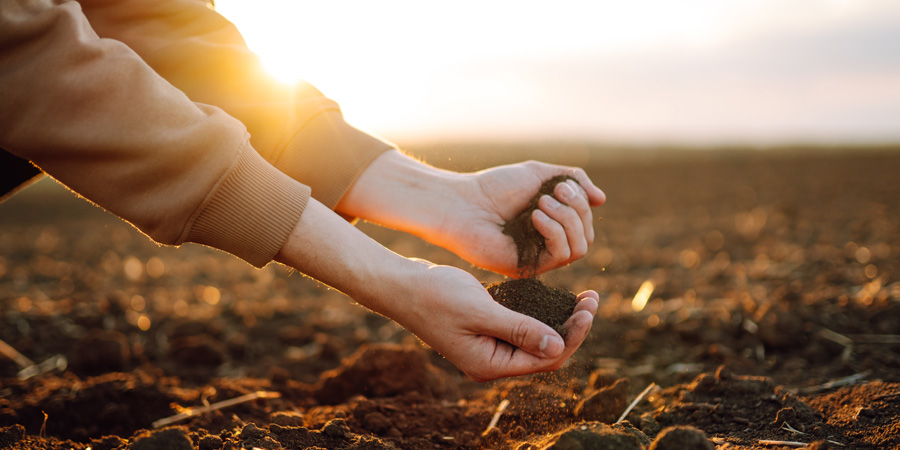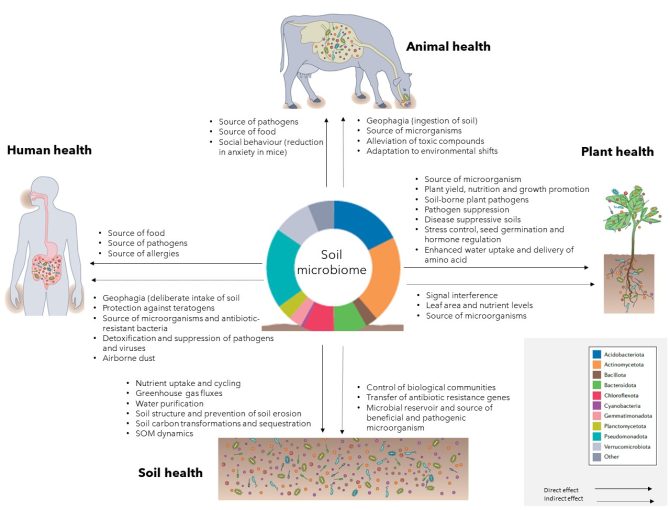Soil microbiomes, a cornerstone of One Health

According to the One Health concept, human health and well- being are inseparably linked to the health of other ecosystem components such as soil, plants and animals. Numerous studies are currently emerging on the crucial role of microorganisms One Health (Berg, 2020). They demonstrate that microbial communities found in plants, animals and humans work as a ‘second genome’ or an ‘eco- holobiont’ (Singh, 2020), and therefore determine the fitness and performance of almost all organisms.
Microbial communities of different organisms are also shown to be interconnected and to form a circular loop (Adair, 2018). However, One Health research landscape is mainly governed by studies on microbial pathogens responsible for zoonotic diseases (Trinh, 2018), while microbiome associations are broader than just pathogens. Indeed, microbial symbionts, commensals, amensals and the overall diversity have important effects for One Health (Berg, 2020). Moreover, soil microbiome received less attention compared with plant, animal and human health, despite its importance for One Health (Mackenzie, 2014; Destoumieux- Garzón, 2018).
Therefore, the present review (Banerjee, 2023) aims to discuss the importance of soil microbiomes for One Health by highlighting the contribution of soil microbial communities to plant, animal and human health.
Microorganisms are overwhelmingly abundant in soils
Soils are particularly rich in microorganisms. They harbour the most diverse and complex microbiome on Earth, with often more than 0.5 mg of microbial biomass carbon and >50,000 species per gram (van der Heijden, 2008; Fierer,2017). Microorganisms residing in the soil and deep surface represent the largest fraction of global biomass, after plants, on Earth and, thus, can act as a microbial reservoir. The dominant microorganisms in soil are generally bacteria and fungi, with more biomass than protists and archaea, followed by virus particles (Bar-On, 2018; Fierer, 2017).
When comparing different microbiome compartment (soil, plant, animal, human), we notice that the diversity and the dominant players vary considerably. For instance, soil and the rhizosphere are highly diverse, dominated by Pseudomonadota, Actinomycetota, Cyanobacteria and Acidobacteriota. Human gut is less diverse and is dominated by the members of Bacillota and Bacteroidota, whereas animal microbiomes are relatively more diverse with a notable presence of Pseudomonadota (Fierer, 2017;Triveldi, 2020).
Soil, a microbial reservoir that determines plant, animal and human microbiomes
Microorganisms link soil, plant, animal and human health, and microbial communities connect the different ecosystems. Soil microbiome is the microbial reservoir that first determines plant microbiome. Indeed, species-specific components of soil microbial communities gather in the rhizosphere of plants and are incorporated into the roots, such that the plants receive a subset of the soil microbiome (Edwards, 2015). Bulk soil is the greatest contributor to plant endophytic microbiota, providing more than two- thirds of the bacterial and fungal diversity (Rochefort, 2021). Yet, plant growth- promoting bacteria can also be transmitted vertically through seeds (Abdelfattah, 2021).
Moreover, soil also determines human and animal gut microbiome. This is due to plant microbiota containing microorganisms originally derived from soil, that can make their way into human and animal gut microbiota. Farmers or farm animals are also regularly exposed to soils, and we also inhale soil particles, including soil microorganisms, through dust. However, dietary intake remains the major contributor to shaping the gut microbiome composition of both humans and animals.
Soil microbiomes contribute to One Health
Soil microbiomes play a pivotal role in ecosystem services and can therefore contribute to One Health by affecting directly and indirectly soil, plant, animal and human health (see figure 1). Multitude critical processes are involved for soil health such as nutrient cycling, organic matter dynamics, soil structure, carbon transformations and sequestration (Fierer, 2017; Naylor, 2020). Soil microorganisms also determine biogeochemical cycling processes, which directly impact climate change mitigation (Fierer, 2017; Bender, 2016) .
Moreover, some microorganisms found in soils can impact positively or negatively plant health. For example, mycorrhizal fungi, Trichoderma spp. and Piriformospora spp. are known for their roles in plant nutrition, growth promotion, hormone regulation and stress control (Tamburini, 2020), whereas numerous soil-borne plant pathogens harm the plant and can cause deadly diseases in animals (e.g. nocardiosis, anthrax, malignant oedema, blackleg) (Morris, 2002). Soil microbiomes have, on the other hand, positive impacts on animals’ health. For instance, they might also influence their social behaviour, as reduced anxiety was observed in mice exposed through dust (Liddicoat, 2020). Similarly, exposure to soil can reduce allergic inflammation and have a positive influence on the gut–lung axis in mice (Ottman, 2019).
In humans, those who are more exposed to soils are less likely to suffer from allergic reactions. However, some microorganisms can cause soil-borne diseases in human such as fungal meningitis, diarrhea, amoebic dysentery and helminthiasis (Wall, 2015).

Based on: Banerjee S, van der Heijden MGA. Soil microbiomes and one health. Nat Rev Microbiol. 2023 Jan;21(1):6-20.
- Soils are demonstrated to be a cornerstone of One Health and serve as a source and reservoir of pathogens, beneficial microorganisms and the overall microbial diversity in a wide range of organisms and ecosystems.
- Soil microbiome has multiple functions that either directly or indirectly contribute to soil, plant, animal and human health.
